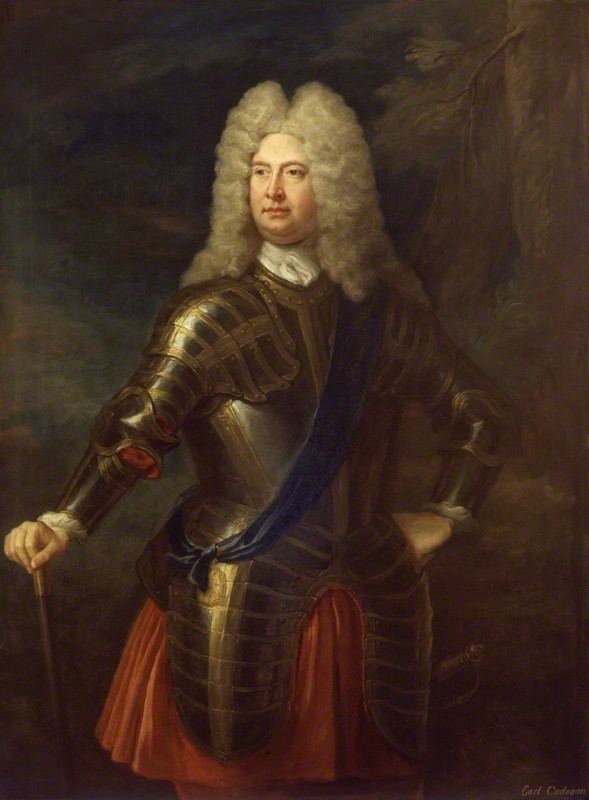Name William 1st | ||
 | ||
Children Sarah Lennox, Duchess of Richmond and Lennox Grandchildren Emily FitzGerald, Duchess of Leinster Similar People Charles Lennox - 2nd Duke, Lady Sarah Lennox, Charles Lennox - 3rd Duke, Emily FitzGerald - Duchess, Lady Louisa Conolly | ||
William Cadogan, 1st Earl Cadogan KT PC (1675 – 17 July 1726) was a noted military officer in the army of John Churchill, 1st Duke of Marlborough during the War of the Spanish Succession. He commanded the 1st Foot Guards for some time.
Contents
Early life
The eldest son of barrister Henry Cadogan, he was educated at Westminster School and Trinity College, Dublin, and joined the army in 1690. He served in Ireland at the sieges of Cork and Kinsale where he first served with Marlborough, then an Earl, and by 1701 was a Major of the Inniskilling Dragoons.
War of the Spanish Succession
In 1701, Cadogan was appointed quartermaster general to Marlborough on the latter's appointment to command the English troops in the Low Countries. During the campaign of 1704, he was one of the few entrusted with the truth of Marlborough's march from the Spanish Netherlands to the Danube and played a major role in the organisation of the march. He fought at the battles of the Schellenberg and Blenheim. Shortly after he was promoted to Brigadier General and became Marlborough's Chief of Staff. He commanded the army's scouting part which located the French army on the morning of Ramillies, and acted as a senior messenger for Marlborough during the battle, recalling Orkney's British infantry from their diversionary attack on the French right flank to assault the French centre around Ramillies itself. At Oudenarde he commanded the allied advance guard, which established crossings over the River Scheldt. In 1706 he was promoted to major-general and commanded the forces which broke through the French left towards the end of the battle. In 1709 he was promoted to lieutenant-general. He fought at Malplaquet, and was wounded in the neck at the siege of Mons, but quickly recovered. At the end of 1709 Cadogan was appointed as a Lieutenant of the Tower of London. During the breaking of the lines of Ne Plus Ultra, he again commanded the allied advance guard, and established a bridgehead across the lines prior to Marlborough's arrival with the main army. After Marlborough's dismissal from his posts at the end of 1711 Cadogan remained with the army, but refused to return with it when Britain withdrew from war in 1712, going into voluntary exile with the Duke. In doing so he lost his rank, positions and emoluments under the crown. George I on his accession, in 1714, reinstated Cadogan, and, amongst other appointments, made him Lieutenant of the Ordnance, under Thomas Erle.
Later life
During Marlborough's voluntary exile during the last years of Queen Anne's reign, Cadogan accompanied him, and often acted as a go-between to maintain Marlborough's links with Britain. When the Hanoverian King George I succeeded in 1714, Cadogan received military favours from the Crown, and in 1715 he replaced the Duke of Argyll in command of the army putting down a Jacobite rising.
On 21 June 1716, he was made Baron Cadogan of Reading, having recently purchased Caversham Park, Oxfordshire (now Berkshire) near that town. He was also made a Knight of the Thistle and, the following year, a member of the Privy Council. (He was a Whig MP for Woodstock from 1705 to 1716.) On 8 May 1718 George I made him 1st Baron Cadogan, of Oakley, co. Buckingham, Viscount Caversham, of Caversham, co. Oxford and Earl Cadogan. In later years he also served as Master of the Robes (1714–1726), Governor of the Isle of Wight (1715–1726) and Master-General of the Ordnance (1722–1725). However, the Opposition's staunch hostility towards him meant that he had lost any political influence several years before his death on 17 July 1726.
He married Margaret Cecilia Munter in April 1704 at The Hague. They had two daughters: Sarah (born 18 September 1705), who married Charles Lennox, 2nd Duke of Richmond, and Margaret (born 21 February 1707), who married the Hon. Charles John Bentinck, fourth son of William Bentinck, 1st Earl of Portland.
